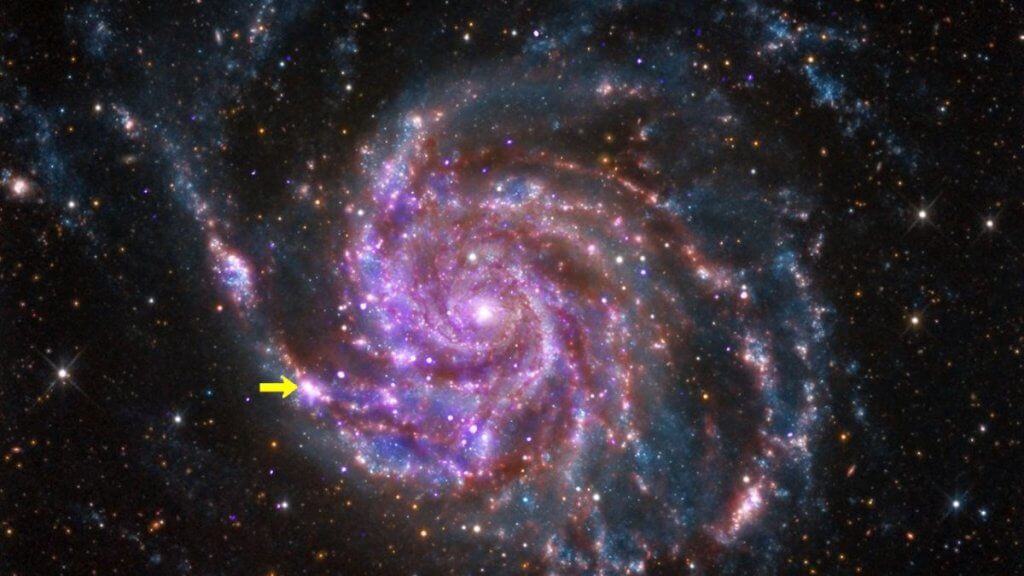
How long will the new supernova visible in the night sky last? (Image Credit: Space.com)
If you haven’t had the chance to observe the new supernova exploding in the night sky, don’t worry — it should be around for another year, maybe more. And it won’t vanish quickly — scientists expect it will slowly fade away until it can no longer be seen in visible light.
The new supernova first burst into view on May 19 when supernova hunter Koichi Itagaki from Yamagata, Japan spotted a new bright spot in the Pinwheel Galaxy. The supernova was confirmed the following day by the Zwicky Transient Facility (ZTF) in California.
Luckily for skywatchers and astrophotographers, astronomers expect the supernova to be visible for some time. “We expect the brightness to sort of hold steady for weeks, if not months,” Daniel Perley, an astrophysicist at Liverpool John Moores Observatory, told Space.com. “It’s gonna stay bright.”
Related: How to see the new supernova in the Pinwheel Galaxy

Looking for a telescope to observe the Pinwheel Galaxy other awesome sights in the night sky? We recommend the Celestron Astro Fi 102 as the top pick in our best beginner’s telescope guide.
If you are hoping to catch a look at the supernova SN 2023ixf, our guides on the best telescopes and best telescopes for beginners are a great place to start. Make sure to get the right telescope eyepiece! A lower-magnification, wide-angle eyepiece should do the trick.
And if you’re looking to snap photos of the supernova, the Pinwheel Galaxy or the night sky in general, check out our guides on the best cameras for astrophotography and best lenses for astrophotography.

Right now, the supernova, known as SN 2023ixf, is one of the largest and brightest seen for a decade. Although it is just beyond the visibility of the unaided human eye, it can be easily glimpsed with a small telescope or even high-magnification binoculars. Located in the galaxy Messier 101 (or M101), also known as the Pinwheel Galaxy, it has quickly become a favorite target for amateur astronomers and their professional colleagues.
Perley suspects it will retain its present brightness for “quite awhile, maybe even up to a couple of months.” Then the supernova will begin to grow fainter. “Over the next year, or two, three years, it’ll finally fade to low detectability again,” Perley said.
Peter Brown, a researcher at Texas A&M Supernova, says that most normal type II supernova, the same classification as SN 2023ixf, have a constant brightness for about 100 days before beginning to drop off.
But the new explosion is a little different from its predecessors, according to Brown. Most Type II supernovas drop off sharply in the ultraviolet range immediately after discovery, but SN 2023ixf has remained consistently bright, saturating observations made with NASA’s multiwavelength Swift space telescope.
“Since this one is different, it might fade” going forward, Brown said. “But it could remain bright enough for an amateur astronomer with a good telescope to see for months.”
Supernovas glow as material blown off the star interact with the surrounding environment. So even if it starts to dim, SN 2023ixf could momentarily rebrighten if it interacts with denser clouds or shells surrounding the dying star.
Even after it can no longer be seen in visible wavelengths, the supernova will likely continue to shine in other parts of the spectrum. Brown said that large telescopes should be able to observe the new discovery for years, while space instruments like NASA’s Hubble telescope or James Webb Space Telescope might be able to study the explosion for decades.
Still, you probably shouldn’t wait another 12 months to drag your telescope outside. While scientists expect the supernova to stick around for some time, there’s no guarantee.
“It could still surprise us,” Perley said. “We don’t know for sure.”
Editor’s Note: If you snap an image of SN 2023ixf, and would like to share it with Space.com’s readers, send your photo(s), comments, and your name and location to spacephotos@space.com.





